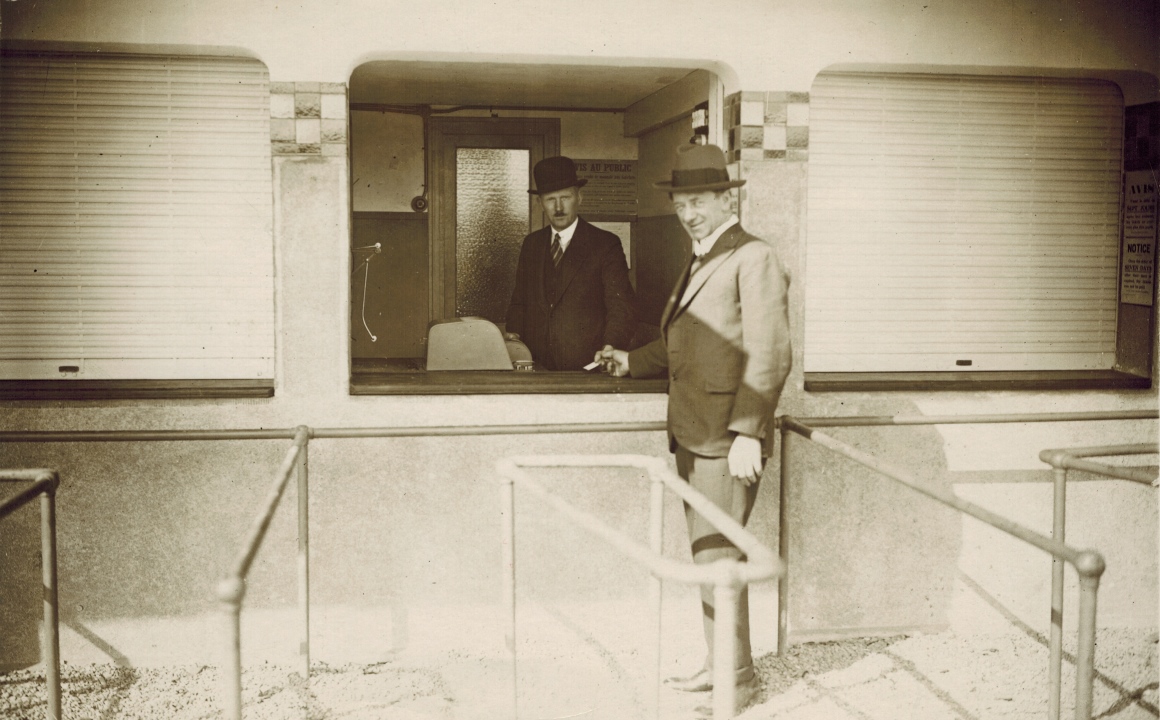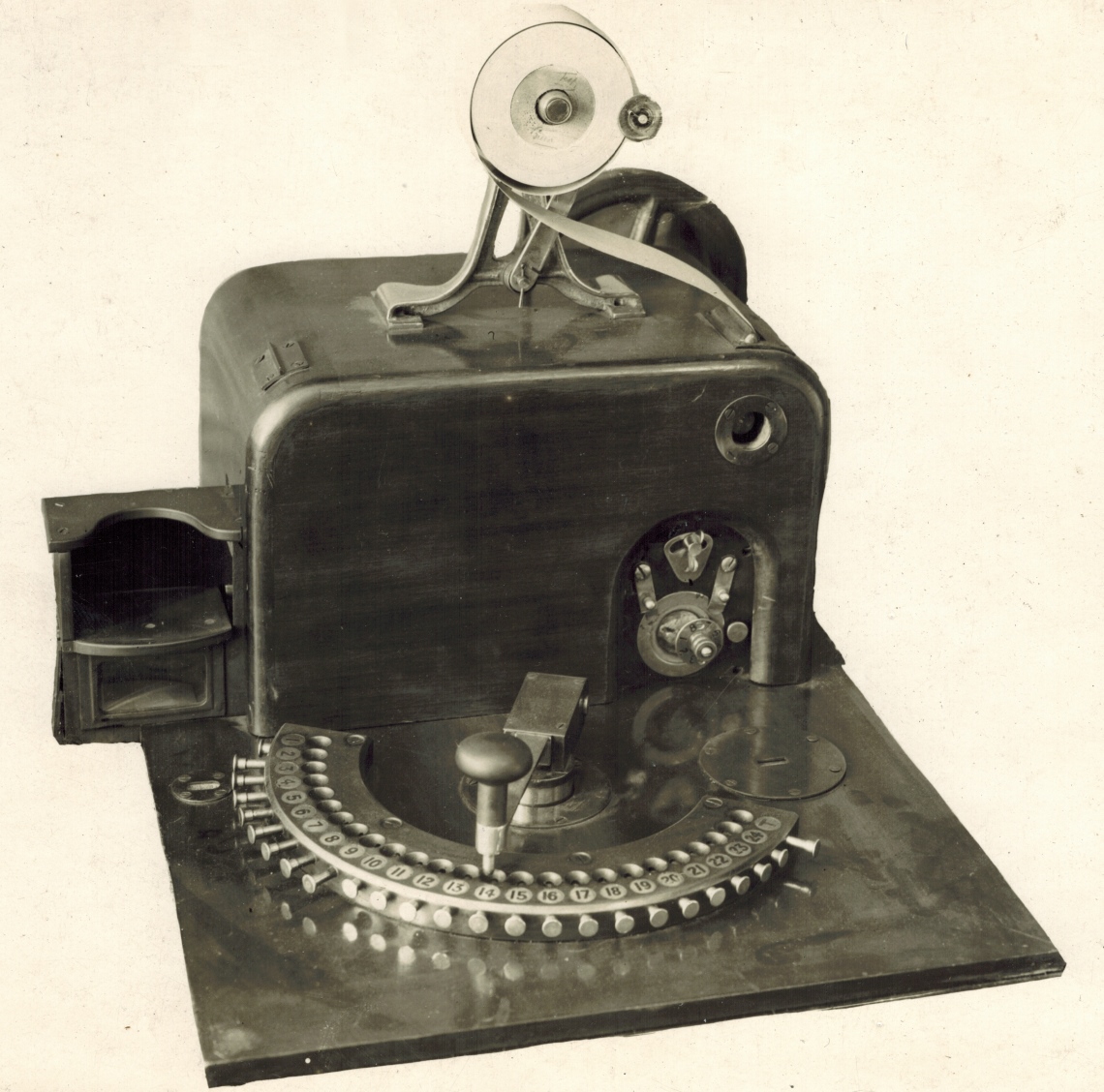This page contains a photograph which is one of several belonging to the photo gallery pages which are part of several pages relating to the invention of the world's first automatic totalizator in 1913 and Automatic Totalisators Limited, the company founded to develop, manufacture and export these systems.
J5 Ticket Issuing Machine Longchamps
This image shows the type of facility where the two hundred and seventy three J5 Ticket Issuing Machines (TIMs) that are Input/Output devices were installed. Part of one of those J5s can be seen in the open booth, ready for action for the first time on opening day at Longchamps. This particular machine is in one of the booths at the bottom of the Longchamps Pavilion. These selling booths each containing a J5, can be seen in the close up view of the pavilion building in the previous photograph in the Photo Gallery and the complete pavilion can be seen in the second image of the Longchamps section of the Photo Gallery. A J5 TIM operator or someone posing as one in the image below, is seen standing inside the selling booth looking out. To the left of the J5 operator the cover of a J5 TIM can be seen protruding upwards from the shelf. The J5 operator enters the details of the customer's bet on the TIM and when it is scanned by the Scanner, the transaction is recorded on the appropriate adder in the machine room and the TIM prints a ticket for the customer. Some of the adders in the machine room mentioned are shown in the first image of the Longchamps section of the Photo Gallery. Additionally, two of the Longchamps Scanner racks each containing six Scanners, are shown in the fourth photograph of the Longchamps section of the Photo Gallery. More after the image...

Click on the image to go back to the Photo Gallery
The photographer's stamp on this photograph reads Jacques BOYER 5bis, Rue Saint-Paul PARIS-IV
Following is the seventh extract from a company document titled The PREMIER (JULIUS) AUTOMATIC TOTALISATOR. The first paragraph in this extract, appears in the company document on page "Ten" which is on the back of page "Nine" containing an image titled FIG. 13. Exterior of ticket selling cubicle on the Longchamps, Paris, Racecourse, showing "two-man" operation. The first paragraph of the extract clearly relates to Figure 13 on the back of the document page that it is printed on, although it is not mentioned. Figure 13 is however located on the right hand side of Figure 12, which is mentioned in the first paragraph of the extract. This side by side location of the two images creates a connection between them, Figure 12 showing a "one-man" operation at Randwick and Figure 13 showing "two-man" operation at Longchamps. The image above is practically the same as Figure 13, except the man outside the booth in the latter is dressed in a uniform, leaving no doubt that he is the second operator mentioned and not a customer. The photo for Figure 13 was obviously taken in the same building as the image above, a conclusion resulting from comparing the size and shape of the selling booths, the roller door openings and in particular the chequerboard pattern band around the top of the pillars separating the booth windows. The first operator inside the booth looks the same in both photos and is wearing the exact same clothes including the tie, which is probably a uniform except that in the above image the hat looks like a Bowler but in Figure 13 it has a crease at the top making it look like a Fedora, that could even be the hat the second operator standing outside the booth is wearing in the image above.
This extract is the seventh in a sequence of extracts from the company document mentioned that are contained in multiple Photo Gallery pages of this website and this extract immediately follows the previous extract in the company document. The previous extract can be read in the Photo Gallery page accessible by clicking on the image at the top of this page and scrolling up in the index table to, and selecting the image thumbnail with associated text starting with the words The type of Julius Tote Ticket Issuing Machine used at Randwick Racecourse... The seventh extract reads:
In the majority of installations the Premier Issuer is operated by one person, who not only prints and issues the tickets, but also receives and counts the money paid in by bettors, as shown in Fig. 12, which is an interior view of a ticket selling cubicle on the Randwick, New South Wales, Racecourse. At Longchamps, in Paris, where the largest totalisator in the world is in use--a Premier equipment throughout--each selling cubicle is staffed by two persons, one operating the printing machine, and the other receiving and checking the moneys received. Such two-man operation is unusual with the Premier equipment, and is in use at Longchamps chiefly because of the fact that it has been the custom for the past 50 years on that Racecourse to operate the Pari Mutuel in that way.
A simpler type of Premier Issuer can also be supplied in which pre-printed tickets are used as shown in Fig.14, but apart altogether from the expense involved in such pre-printing, this machine, whilst convenient and speedy cannot afford the same measure of check over the issuing of tickets as is achieved by the full automatic Premier Machine.
Every Premier Ticket Issuer is equipped with a small counter which records the number of tickets issued on each race by the operator, so that a complete check is available regarding the moneys for which each operator is responsible. The full automatic issuer can, if desired, be fitted with additional printing apparatus, which will print on the back of every ticket any desired advertisement. All the Longchamps selling machines are equipped with this accessory.
The Issuer mentioned in the above document is an antiquated name for a TIM. I have not presented Fig. 12 as it is very low resolution and not suitable for reproducing, however the TIM in the following image is identical to the one in use in Fig 12. Unlike the Randwick TIM shown below, the J5s at Longchamps had a metal cover over the print mechanism rather than the wooden looking one in the image below.
The Randwick Premier TIM 
Thanks to Mike Bell, who used to be an Automatic Totalisators Limited Project Manager and Programmer, for sending me a scanned version of The PREMIER (JULIUS) AUTOMATIC TOTALISATOR which brought the extract above to my attention. I do have an original hard-copy version of this document.
The next extract from this company document, which immediately follows on from the extract above, is titled Ticket Values and is in the second page of the photo gallery under the heading Ticket Issuing Machines (TIMs). To read it click on the image at the top of this page, scroll down to the bottom of the page and select the Next page option in the Navigation Bar. Then scroll down in the photo gallery index to the previously mentioned heading and select the image thumbnail below the heading with associated text starting The type of TIM in use at Randwick Racecourse in 1917.
The additional printing apparatus which prints advertisements on the back of every ticket, referred to in the third paragraph of the company document extract above, is very interesting to me. I had no idea that printing advertisements on the back of tote tickets was available so long ago. I only worked on the computer based totalisator systems and none of the earlier technologies. During this later epoch, I thought I had originated this idea of printing advertisements on tickets. As I later discovered there were other contemporaries of mine who also had independently originated that thought. Despite effort being put into trying to conjure up interest in this idea, I never succeeded in getting it implemented on the tracks at which I was responsible for the totalisator systems. There are examples of tickets on this website that have advertisements on the back of the tickets. Despite digital computers with their inherent versatility being the closest thing to Turing's Universal Machine dream come true, getting them to do something new, boils down to a programming task which costs money and consequently has an inherent resistance to change associated with it. It was not until TAB Limited took over the operations on the Queensland Racetracks that ATL had previously serviced, that a system was introduced that could print a graphic with associated text on the front of the ticket when it was issued. This was usually used to print the race, trotting or greyhound club's logo on every ticket. It is incredible that it took something in the order of 80 years to re-discover and re-implement this 1928 technology achievement, despite half of this period being in the Digital Computer era.
The device protruding from the left hand wall of the selling booth and dangling down towards the shelf in the image at the top of this page, is a ticket paper roll holder and dispenser. This device had no paper roll loaded when the photo was taken. The paper roll is placed on the spindle at the junction of two projecting arms from the wall one near perpendicular to the wall and the other at about 45 degrees to the wall forming a right angled triangle with the wall. The paper then feeds down and under the bottom roller which is at the lowest point of the paper holder and from there enters the J5. As the ticket paper dispenser is empty, and the neighbouring selling booths have their roller doors down I am convinced this is not a race day and suspect that this photo was taken prior to opening, whilst the finishing touches are still being applied during the installation phase and that the people have posed for the photograph. The prior image to the one at the top of this page in the Photo Gallery, consolidates the idea that the finishing touches are being added to the installation prior to opening, as it is evident from that image that workers are still working on the front of the Longchamps Pavilion. The first paragraph of the company document extract above tells us that the second person in the image at the top of this page, who is standing outside the window is a second operator in a two man operation. Additionally, FIG 13 in the the company document mentioned shows the second operator standing outside the booth wearing a uniform that makes him look like a Gendarme. Perhaps this Gendarme like outfit is the proper uniform for the second operator and not the garb worn by the second operator shown in the image at the top of this page, consolidating the thought that this image has been posed.

